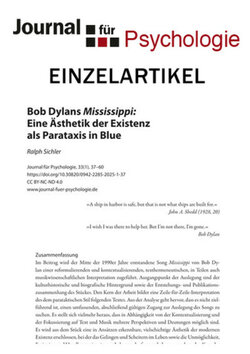24 Seiten, PDF-E-Book
Erschienen: Juni 2025
Bestell-Nr.: 34128
https://doi.org/10.30820/0942-2285-2025-1-37
abonnieren
Ralph Sichler
Bob Dylans Mississippi: Eine Ästhetik der Existenz als Parataxis in Blue (PDF)
Sofortdownload
Dies ist ein E-Book. Unsere E-Books sind mit einem personalisierten Wasserzeichen versehen,
jedoch frei von weiteren technischen Schutzmaßnahmen (»DRM«).
Erfahren Sie hier mehr zu den Datei-Formaten.
Im Beitrag wird der Mitte der 1990er Jahre entstandene Song Mississippi von Bob Dylan einer reformulierenden und kontextualisierenden, texthermeneutischen, in Teilen auch musikwissenschaftlichen Interpretation zugeführt. Ausgangspunkt der Auslegung sind der kulturhistorische und biografische Hintergrund sowie der Entstehungsund Publikationszusammenhang des Stückes. Den Kern der Arbeit bildet eine Zeile-für-Zeile-Interpretation des dem parataktischen Stil folgenden Textes. Aus der Analyse geht hervor, dass es nicht zielführend ist, einen umfassenden, abschließend gültigen Zugang zur Auslegung des Songs zu suchen. Es stellt sich vielmehr heraus, dass in Abhängigkeit von der Kontextualisierung und der Fokussierung auf Text und Musik mehrere Perspektiven und Deutungen möglich sind. Es wird aus dem Stück eine in Ansätzen erkennbare, vielschichtige Ästhetik der modernen Existenz erschlossen, bei der das Gelingen und Scheitern im Leben sowie die Unmöglichkeit, Ereignisse und Handlungen im eigenen Lebensverlauf ungeschehen zu machen, den Kern der Reflexion bilden. Der Song wird als Ausdruck einer ästhetischen Grundhaltung verstanden, die sich durch die Überwindung von letzten Gewissheiten, das Akzeptieren von Ambiguität und Unvollständigkeit und der Suche nach einer zutiefst individuellen Form von reflektierter Selbstentfaltung charakterisieren lässt.
Abstract:
This article presents a reformulating and contextualizing, text-hermeneutic, and in part musicological interpretation of Bob Dylan’s song Mississippi which was written in the mid-1990s. The starting point for the interpretation is the cultural-historical and biographical background as well as the context in which the song was composed and published. The core of the paper is a line-by-line interpretation of the text, which follows its paratactic style. The analysis shows that it is not useful to look for a comprehensive, conclusively valid approach to interpreting the song. Rather, it turns out that, depending on the contextualization and the focus on the lyrics and music, multiple perspectives and interpretations are possible. The piece reveals a somewhat recognizable, multifaceted aesthetic of modern existence, in which success and failure in life, as well as the impossibility of undoing events and actions in one’s own life, form the core of reflection. The song is understood as an expression of a fundamental aesthetic attitude characterized by the overcoming of ultimate certainties, the acceptance of ambiguity and incompleteness, and the search for a deeply individual form of reflective self-actualization.
Abstract:
This article presents a reformulating and contextualizing, text-hermeneutic, and in part musicological interpretation of Bob Dylan’s song Mississippi which was written in the mid-1990s. The starting point for the interpretation is the cultural-historical and biographical background as well as the context in which the song was composed and published. The core of the paper is a line-by-line interpretation of the text, which follows its paratactic style. The analysis shows that it is not useful to look for a comprehensive, conclusively valid approach to interpreting the song. Rather, it turns out that, depending on the contextualization and the focus on the lyrics and music, multiple perspectives and interpretations are possible. The piece reveals a somewhat recognizable, multifaceted aesthetic of modern existence, in which success and failure in life, as well as the impossibility of undoing events and actions in one’s own life, form the core of reflection. The song is understood as an expression of a fundamental aesthetic attitude characterized by the overcoming of ultimate certainties, the acceptance of ambiguity and incompleteness, and the search for a deeply individual form of reflective self-actualization.
Ralph SichlerS. 3–12Editorial (PDF)
Carsten HeinzeS. 13–36Düstere Klänge in Jugend(-sub-)kulturen und Szenen (PDF)
Ein historischer Differenzierungsversuch im Zeitraum der 1970er bis zu den 1990er JahrenRalph SichlerS. 37–60Bob Dylans Mississippi: Eine Ästhetik der Existenz als Parataxis in Blue (PDF)
Agnes StephensonS. 61–79The Origin of Love (Hedwig and the Angry Inch) (PDF)
Über Komplementarität, queere Populärkultur und KugelmenschenRisto LenzS. 80–101»Roh, fehlbar und menschlich« (PDF)
Frank Ocean als Confessional Singer-Songwriter des DigitalenChristian SchröderS. 102–121Religiöse Identität durch säkulare Musik (PDF)
Playlists als Element post-konfessioneller LebensstileCelia Wolter RodríguezS. 122–143Zur Bedeutung von Deutschrap für jugendliche Hörer*innen im Kontext ihrer Lebensgeschichte (PDF)
Eine intersektionale PerspektiveRudolf MaisrimlS. 144–165Show me the way to the next Whiskey Bar (PDF)
Der Song in der Suchtbehandlung
Carsten HeinzeS. 13–36Düstere Klänge in Jugend(-sub-)kulturen und Szenen (PDF)
Ein historischer Differenzierungsversuch im Zeitraum der 1970er bis zu den 1990er JahrenRalph SichlerS. 37–60Bob Dylans Mississippi: Eine Ästhetik der Existenz als Parataxis in Blue (PDF)
Agnes StephensonS. 61–79The Origin of Love (Hedwig and the Angry Inch) (PDF)
Über Komplementarität, queere Populärkultur und KugelmenschenRisto LenzS. 80–101»Roh, fehlbar und menschlich« (PDF)
Frank Ocean als Confessional Singer-Songwriter des DigitalenChristian SchröderS. 102–121Religiöse Identität durch säkulare Musik (PDF)
Playlists als Element post-konfessioneller LebensstileCelia Wolter RodríguezS. 122–143Zur Bedeutung von Deutschrap für jugendliche Hörer*innen im Kontext ihrer Lebensgeschichte (PDF)
Eine intersektionale PerspektiveRudolf MaisrimlS. 144–165Show me the way to the next Whiskey Bar (PDF)
Der Song in der Suchtbehandlung

